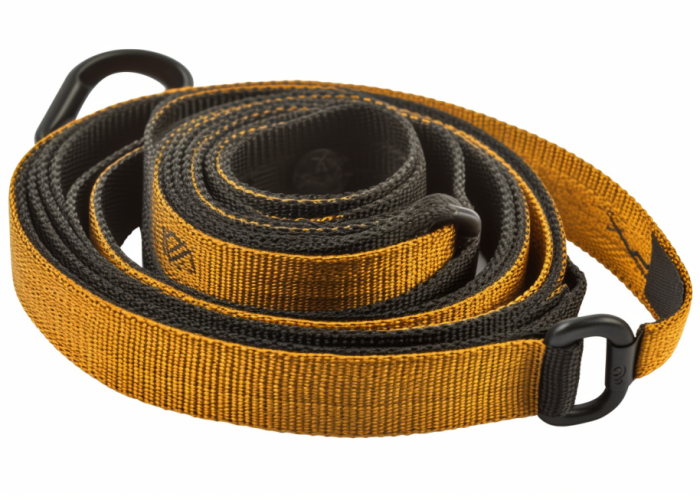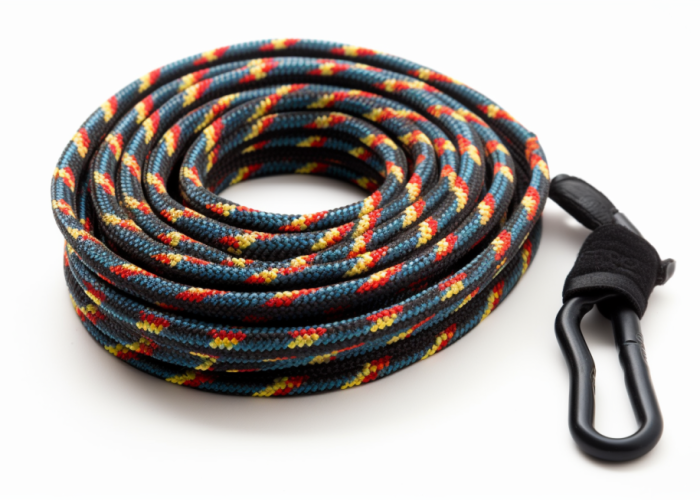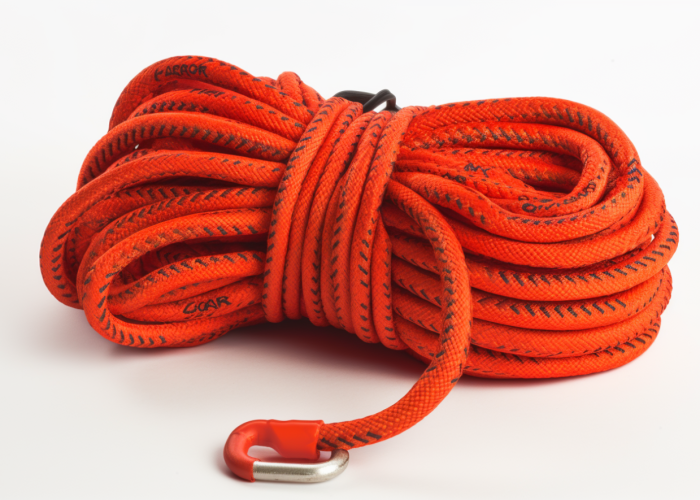Marine environments rapidly destroy standard webbing through UV exposure, saltwater damage, and microbial growth. Selecting the correct marine-grade material is crucial for product longevity and safety in these harsh conditions. Our custom manufacturing capabilities can deliver application-specific webbing solutions engineered for your exact marine performance requirements.
Marine grade webbing is specialized synthetic webbing engineered with enhanced UV protection, water resistance, and antimicrobial treatments specifically for maritime environments. These materials maintain 80-90% strength after prolonged sun exposure and resist the 30-40% strength loss that water absorption causes in standard webbing. Marine-grade webbing is manufactured from polyester, nylon, polypropylene, or hybrid materials, each offering specific performance advantages for different marine applications.
Compare the four main marine webbing materials, explore key performance data, and get expert guidance to select the best webbing for durability and longevity in your marine products.


Webbing manufacturing expert with 15+ years of experience helping product developers build high-performance straps for industrial, medical, and outdoor use.
Polyester, nylon, polypropylene, and specialty hybrid materials are the four primary materials used in marine grade webbing. Each material offers distinct performance characteristics for marine environments, with polyester providing excellent UV resistance, nylon offering superior strength, polypropylene delivering enhanced moisture resistance, and specialty blends combining multiple beneficial properties for specific marine applications.
At a glance:
Polyester Marine Webbing (Most Cost-Effective)
Marine-grade polyester webbing offers the best balance of performance and cost. Its molecular structure provides natural UV resistance, maintaining 85-90% strength after prolonged sun exposure. ASTM D6775 certified with 500 ft MOQ.
Nylon Marine Webbing (Best for Dynamic Loads)
Nylon webbing delivers superior tensile strength with 15-20% greater breaking strength than equivalent polyester. Its natural elasticity absorbs shock loads, making it ideal for applications with sudden force changes. 2-3 week lead times for custom orders.
Polypropylene Marine Webbing (Most Water-Resistant)
Polypropylene webbing provides complete water resistance with zero moisture absorption. This material excels with constant water contact and harsh chemicals, including saltwater, fuel, and cleaning solutions. No minimum order for stock colors.
Specialty Hybrid Marine Webbing (Premium Performance)
Hybrid materials combine multiple fiber types to achieve superior performance characteristics. These engineered solutions typically cost 40-60% more than standard materials but deliver 3x longer service life. 3-4 week lead times with 1,000 ft minimum.
Selection Guide
Material Best For When to Choose Limitations
Polyester Outdoor exposure UV is primary concern Moderate strength when wet
Nylon Dynamic loads Applications with movement/impact Requires UV treatment
Polypropylene Wet environments Constant moisture exposure Lower tensile strength
Hybrid Custom solutions Standard specs insufficient Higher cost, longer lead time
Customization Options
All marine-grade webbing materials can be customized with specialized treatments including edge sealants, fire retardants, and antimicrobial additives. Free sample packs available for testing before production.

UV resistance directly determines the usable lifespan of marine grade webbing, with properly treated materials retaining 80-90% of original strength after 3-5 years of sun exposure. Untreated webbing can deteriorate within a single season, losing up to 60% tensile strength and becoming brittle, faded, and prone to catastrophic failure when exposed to the intense UV radiation present in marine environments.
At a glance:
Ultraviolet radiation attacks synthetic webbing at the molecular level, breaking polymer chains and weakening the material structure. This process accelerates in marine environments where water reflection can increase UV exposure by up to 25%.
Modern marine webbing incorporates UV stabilizers and absorbers throughout the fiber, not just as surface treatments. These additives intercept and dissipate UV energy before it damages crucial polymer bonds.
Selection Guide
Material UV Resistance Treatment Options Expected Lifespan Price Impact
Polyester Excellent (natural) Carbon black, titanium dioxide 3–5 years Standard
Nylon Moderate (needs treatment) HALS additives, benzotriazole 2–4 years +15%
Polypropylene Poor (requires extensive treatment) Hindered amine light stabilizers 1–3 years +10%
Hybrid Customizable Engineered protection systems 3–7 years +25%
Quality marine webbing undergoes ASTM G154 accelerated weathering testing, simulating multiple years of UV exposure. Look for test results showing strength retention percentages after standard test cycles.
Water and chemical resistance prevent strength loss of up to 40% and microbial deterioration that can render webbing unusable within a single season in marine environments. Beyond basic moisture protection, true marine grade webbing withstands continuous exposure to saltwater, fuel contaminants, cleaning chemicals, and biological growth without significant performance degradation.
At a glance:
Standard synthetic webbing can absorb 5-15% of its weight in water, leading to 30-40% reduction in tensile strength while wet and accelerated UV degradation through magnification effects.
Saltwater creates unique deterioration challenges through both chemical action and crystallization processes that attack fiber integrity at the microscopic level, accelerating degradation 2-3x faster than freshwater.
Selection Guide
Material Water Resistance Chemical Resistance Treatments Available Applications
Polyester Good (3–5% absorption) Good (general resistance) Fluorocarbon coatings General marine use
Nylon Fair (8–15% absorption) Moderate (affected by some chemicals) Hydrophobic coatings Dry applications
Polypropylene Excellent (0–1% absorption) Excellent (broad resistance) Inherent resistance Constant immersion
Hybrid Customizable Engineered for specific exposures Multi-layer protection Chemical environments
The combination of moisture, warmth, and organic contaminants in marine environments creates ideal conditions for mold and mildew growth that can reduce webbing strength by 20-30% and create health hazards.
Marine grade webbing requires 40-60% higher abrasion resistance and 30-50% greater tensile strength than standard commercial webbing due to the harsh operating conditions and safety-critical nature of marine applications. These enhanced performance requirements ensure material integrity when subjected to continuous motion, saltwater exposure, and dynamic loading conditions typical in marine environments.
At a glance:
Marine environments create severe abrasion challenges through constant motion, salt crystal formation, and contamination with abrasive particles like sand and marine sediment.
Marine applications typically require 30-50% higher breaking strength than comparable land-based uses due to dynamic loading, shock forces, and the safety-critical nature of many marine applications.
Selection Guide
Application Required Tensile Strength Abrasion Rating Recommended Material Sample Testing
Safety/Lifting 6,000–12,000 lbs (2″) 20,000+ cycles Nylon or Hybrid Free samples available
Covers/Shades 3,000–5,000 lbs (2″) 15,000+ cycles Polyester 48-hour testing
Water Contact 2,000–4,000 lbs (2″) 15,000+ cycles Polypropylene No minimum order
Heavy-Duty 8,000+ lbs (2″) 25,000+ cycles Specialty Hybrid Custom solutions
Quality marine webbing undergoes comprehensive testing regimens including cyclical loading, wet tensile testing, and combined environmental/mechanical stress testing to verify performance under real-world conditions.

Marine-grade treatments create multiple protective barriers that prevent up to 95% of mold growth and maintain 85-90% of original color intensity even after 3-5 years of exposure. These specialized treatments penetrate the fiber structure rather than merely coating the surface, ensuring long-term protection against both biological deterioration and aesthetic degradation in harsh marine environments.
At a glance:
Marine-grade webbing typically uses solution-dyed fibers where color is incorporated during fiber formation rather than applied to the surface, creating inherent colorfastness that outperforms surface dyeing by 300-400%.
Quality marine webbing incorporates antimicrobial agents including silver ion technology or quaternary ammonium compounds that disrupt cellular processes of microorganisms attempting to colonize the material.
Selection Guide
pplication Treatment Recommendation Color Retention Antimicrobial Rating Lead Time
Exterior Continuous Solution-dyed + UV stabilizers 85–90% after 3 years 95% reduction 2 weeks
Interior Marine Solution-dyed + antimicrobial 90–95% after 3 years 99% reduction 1 week
Saltwater Exposure Comprehensive treatment system 80–85% after 3 years 90% reduction 2–3 weeks
Custom Colors Matched solution-dying Custom warranties Custom protection 3–4 weeks
Quality marine treatments undergo verification testing under AATCC Test Method 30 for antimicrobial efficacy and AATCC Test Method 169 for color retention after accelerated weathering.
Specialized marine applications require webbing engineered for specific performance profiles, with properties customized for the unique challenges of each use case. From the extreme UV exposure of sail rigging to the constant moisture of dock lines, each application presents a distinct combination of environmental and mechanical stresses that demand specialized webbing characteristics.
At a glance:
Sail rigging applications require exceptional UV resistance combined with minimal stretch (0.5-2%) to maintain precise sail shape and control under varying wind conditions.
Life jackets, harnesses, and man-overboard systems require webbing with 3,000-6,000 lbs tensile strength and controlled elongation (8-15%) to absorb shock forces while preventing excessive stretch.
Selection Guide
Application Critical Properties Recommended Material Testing Standards Custom Options
Sail Control UV resistance, low stretch High-tenacity polyester ASTM D4758 Custom widths, colors
Safety Equipment Tensile strength, controlled stretch Nylon or specialty hybrid ISO 10333, UL 1180 Safety certification
Covers & Tops UV + mildew resistance Treated polyester ASTM D4355 Custom colors, widths
Underwater Use Water/chemical resistance Polypropylene ASTM F1740 No minimum for stock
Boat covers, bimini tops, and enclosure applications require superior mildew resistance combined with excellent UV protection and moderate strength characteristics (1,500-3,000 lbs).
Marine grade webbing materials display distinct performance profiles across critical attributes, with each material offering specific advantages for particular applications. This comparative analysis helps engineers select the optimal material based on the specific requirements of their marine application, balancing performance characteristics against cost considerations.
At a glance:
Comparative Performance Matrix
Material UV Resistance Tensile Strength Water Resistance Chemical Resistance Price Range MOQ
Polyester Excellent Good Good Good $0.25–$0.45/ft 500 ft
Nylon Good (treated) Excellent Fair Good $0.30–$0.55/ft 500 ft
Polypropylene Fair (treated) Fair Excellent Excellent $0.22–$0.40/ft Stock available
Hybrid Very Good–Excellent Excellent Very Good Very Good $0.45–$0.80/ft 1,000 ft
Polyester provides the best natural UV resistance, retaining 85-90% strength after long-term exposure without specialized treatments. Hybrid materials can achieve similar performance with protective additives.
Specialty hybrid materials achieve the highest strength-to-weight ratios (up to 15,000 lbs in 2″ width), followed by nylon with excellent tensile properties and beneficial stretch characteristics.
Engineers should prioritize seven critical technical specifications when selecting marine webbing to ensure optimal performance and safety margins for specific applications. Beyond basic material selection, these detailed specifications determine the webbing’s suitability for particular marine environments and mechanical requirements, directly impacting product performance and lifespan.
At a glance:
Specification Selection Matrix
Critical Specification Testing Standard What to Request Why It Matters Customization Options
Breaking Strength ASTM D6775 Minimum guaranteed value Safety margin calculation Custom certifications
UV Resistance ASTM G154 % strength retention after 1000 hours Determines lifespan Enhanced treatments
Water Absorption ISO 9073-6 % weight gain & wet strength retention Performance when wet Hydrophobic coatings
Abrasion Resistance ASTM D3884 Cycles to failure on Taber abrader Predicts wear life Reinforced constructions
Operating Temperature ASTM D746 Performance range °F/°C Environmental suitability Cold-weather formulations
Chemical Resistance ASTM D543 Specific resistance ratings Application-specific exposure Custom protection
Antimicrobial Efficacy AATCC TM30 Log reduction in growth Prevents deterioration Enhanced treatments
Engineers must specify both minimum breaking strength (typically 3,000-12,000 lbs depending on width) and appropriate safety factors (5:1 to 7:1 for critical marine applications).
UV resistance should be quantified as percentage strength retention after standardized testing (ASTM G154) rather than subjective ratings, with 80% retention being the minimum benchmark.
Request our comprehensive testing program for your specific application, including free sample materials and application-specific testing protocols to verify performance. Results typically available within 5-7 business days to support your development timeline.
Marine grade webbing selection requires balancing material properties, environmental factors, and application requirements. The right webbing choice significantly impacts product performance, safety, and longevity in harsh maritime conditions. Contact us to explore manufacturing solutions tailored to your product requirements – from custom treatments to application-specific performance testing.
Yes, marine grade webbing delivers 3-5x longer service life and significantly reduces product failure rates, justifying the 15-30% price premium over standard webbing. The reduced warranty claims and maintenance costs typically offset the initial investment within the first season of use, providing better long-term value for marine applications.
Marine grade webbing for safety applications must meet ISO 10333, UL 1180, and USCG requirements, while maintaining performance after environmental exposure testing under ASTM D4355. These standards establish minimum breaking strength retention after UV and saltwater exposure, with safety applications requiring testing certification documentation.
Saltwater affects each webbing material differently, with polypropylene showing virtually no strength loss, polyester losing 5-8% strength, and untreated nylon losing up to 20-30% strength when wet with saltwater. Salt crystal formation inside fibers presents a greater long-term deterioration risk than the immediate strength effects of moisture absorption.
Request application-specific test documentation for strength retention after UV exposure (ASTM G154), wet strength characteristics (ISO 9073-6), and abrasion resistance (ASTM D3884). For critical applications, also specify testing under combined conditions that simulate your specific environment, such as cyclic testing with salt spray exposure.
No, effective marine grade webbing requires both specialized base materials and comprehensive treatment processes integrated during manufacturing. Post-manufacturing treatments on standard webbing provide only surface protection that typically deteriorates within 3-6 months, unlike true marine-grade materials with protection throughout the fiber structure.
Properly selected marine grade webbing lasts 3-5 years in continuous outdoor marine exposure, compared to 6-12 months for standard webbing. This lifespan varies based on material selection, specific environmental conditions, and whether the application involves constant immersion or intermittent exposure.